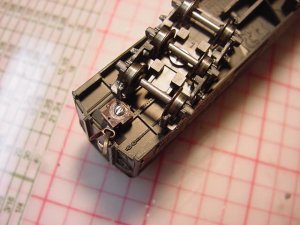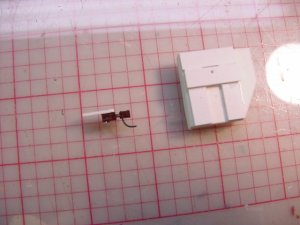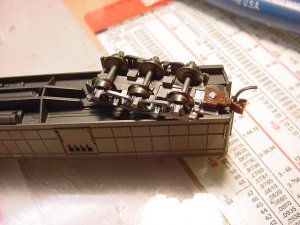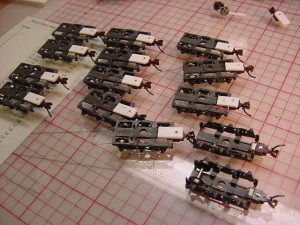I am new to model railroading. I am building a 9x10 around the room layout in N scale. I want to convert all my rolling stock to Micro Train couplers. The problem is that I have no idea which ones to get. Do I need to buy the trucks and couplers together? If so, which trucks. I model modern day equipment. I notice all sorts of different types of trucks and couplers. Can someone give me some insight?
coupler and truck conversions
- Thread starter ajroland
- Start date
You are using an out of date browser. It may not display this or other websites correctly.
You should upgrade or use an alternative browser.
You should upgrade or use an alternative browser.
I too was confused to bits. No, you don't need all the variations. For the vast majority of locos and rolling stock, you're best off with the 'standard' 1015 body-mounted coupler sets. You can get these assembled in pairs, or (much cheaper) in 10-packs unassembled, in your choice of black or brown. A Micro-Trains 'starter pack' which contains the gauges and assembly jig would be strongly recommended too. That's about all you need, really. I use:
MT starter pack (only need one of these, contains everything)
10-pack of 1015 couplers (10 pairs, that is), one pack per ten cars/locos you have
then, I also bought a 20-pack of MT trucks without couplers (for those that I need to change out), and a 100-pack of MT low profile wheelsets (for when I want to swap out non-low-profile wheels).
You only need to get involved with the complex stuff if/when you want to:
(1) convert odd locos, or very long passenger or autorack cars
(2) swap out trucks for the correct prototypical versions, if they're wrong
(3) errrr that's about it, I think
See, easy!
On the trucks you have, a sharp knife is all you need to chop off the existing couplers, and then you can install the body-mounted couplers...
Charles
MT starter pack (only need one of these, contains everything)
10-pack of 1015 couplers (10 pairs, that is), one pack per ten cars/locos you have
then, I also bought a 20-pack of MT trucks without couplers (for those that I need to change out), and a 100-pack of MT low profile wheelsets (for when I want to swap out non-low-profile wheels).
You only need to get involved with the complex stuff if/when you want to:
(1) convert odd locos, or very long passenger or autorack cars
(2) swap out trucks for the correct prototypical versions, if they're wrong
(3) errrr that's about it, I think
See, easy!
On the trucks you have, a sharp knife is all you need to chop off the existing couplers, and then you can install the body-mounted couplers...
Charles
Thanks, for the information. I am going to get me a starter pack and go from there. I'm glad I found this site.
Body mounting your couplers is one option. Another way is to change out the trucks and replace them with the Micro Trains truck-coupler combos. If you are relatively new to model rr ing, changing the complete truck-coupler combo is much easier than just changing couplers and trying to get the heighth and alignment correct. By using the Micro-Trains truck-coupler combos, your couplers will all be at the correct height.
Yes, that's correct, and it's easier. But there will come a time in the not-too-distant future when you get problems (with switching, coupling, uncoupling, and derailing) and want to swap them out for body-mounted couplers. Unless you're a complete butterfingers and are sure you can't do it, I'd suggest you save yourself the time, money, and exasperation and go straight to body-mount. Others might suggest different, of course, this is just what I've found myself...
I just put the truck -coupler out there as an option. I have changed almost all my cars by just switching to the MT truck-couplers. I have assembled just the couplers for my engines though. Assembling the couplers is easy enough but for a newbee getting the height right could be a frustrating thing.
As for the operation aspect, I haven't yet experienced any problems with the truck mounted couplers. But I am using the large flange wheels.
As for the operation aspect, I haven't yet experienced any problems with the truck mounted couplers. But I am using the large flange wheels.
tillsbury & n gineer: Do you have any comments on using truck-couplers versus body mounted couplers based on the length of the car ie. long passenger and or freight cars versus regular freight cars?
Thanks
Dwight77
Thanks
Dwight77
There are probably more out there with more experience of longer cars than I. I suggest that it'd only be significant if you had very small radiused curves for the length of car that you intend to use.
The problem with truck-mounted couplers is when you are pushing cars (reversing or sorting). If you go round a corner (through a switch or pair of switches into a yard, for example), the 'pushing' part of the train is pushing the coupler at an angle. This produces a rotational force on the truck, which pushes the inside axle (the one furthest from the coupler) towards the inside of the curve. It can pick points or even jump out of the tracks altogether. The effect is particularly bad with any combination of points, dodgy trackwork, rail joints, lightweight empty gondolas, and so on. Longer trains create more force (as there are more cars resisting the push), making it worse...
It only tends to happen shuffling large numbers of lighter-weight cars with low-profile flanges. If all your cars are weighted, with pizza-cutters and your trackwork is above average you may never see the problem.
The other problem I have is with magnetic uncoupling. Wheelsets aren't exactly in gauge (by that I mean the entire width of the inside of the track, even if they are 'correct'). This means that with a truck-mounted coupler, particularly a long-shank one, there is some side-to-side slop in the coupler before it actually starts to open. The truck can rotate quite easily. With a body-mounted coupler the total side-to-side movement is limited by the length of the car (the entire body has to move sideways over the axles), and is therefore much less than with truck-mounted couplers. I find that this makes magnetic uncoupling a lot more reliable. If you are happy to do uncoupling manually this won't be an issue for you.
Charles
The problem with truck-mounted couplers is when you are pushing cars (reversing or sorting). If you go round a corner (through a switch or pair of switches into a yard, for example), the 'pushing' part of the train is pushing the coupler at an angle. This produces a rotational force on the truck, which pushes the inside axle (the one furthest from the coupler) towards the inside of the curve. It can pick points or even jump out of the tracks altogether. The effect is particularly bad with any combination of points, dodgy trackwork, rail joints, lightweight empty gondolas, and so on. Longer trains create more force (as there are more cars resisting the push), making it worse...
It only tends to happen shuffling large numbers of lighter-weight cars with low-profile flanges. If all your cars are weighted, with pizza-cutters and your trackwork is above average you may never see the problem.
The other problem I have is with magnetic uncoupling. Wheelsets aren't exactly in gauge (by that I mean the entire width of the inside of the track, even if they are 'correct'). This means that with a truck-mounted coupler, particularly a long-shank one, there is some side-to-side slop in the coupler before it actually starts to open. The truck can rotate quite easily. With a body-mounted coupler the total side-to-side movement is limited by the length of the car (the entire body has to move sideways over the axles), and is therefore much less than with truck-mounted couplers. I find that this makes magnetic uncoupling a lot more reliable. If you are happy to do uncoupling manually this won't be an issue for you.
Charles
I think I will try both truck and coupler combo as well as body mount. How about metal wheel sets? Do you need metal wheels to really have good performance or is it mostly the track work that counts.
The body mount does seem the way to go. I am planning to build me a test track just for the purpose of changing couplers.
The body mount does seem the way to go. I am planning to build me a test track just for the purpose of changing couplers.
Many people swear by metal wheels, saying they keep the track cleaner. I use mainly Kato locos and I don't seem to have the same problem. My Atlas and LL locos are not reliable on clean trackwork and stop dead when it gets a little dirty, so they're just stationary models now. I mostly use MT lo-pros, but rarely have to clean the track. Interestingly, I've heard many Kato Unitrack users saying they don't have to clean the track often -- I wonder if there's a connection (i.e. if the track or the locos are Kato you're ok, otherwise you have to keep stuff clean?). The wheels certainly seem to be different from my other locos and don't seem to get as dirty.
Next gotcha -- metal wheelsets preclude the use of magnetic uncoupling (the cars zoom towards the magnets when you're trying to uncouple them). Just be aware before you spend too much money!
Charles
Next gotcha -- metal wheelsets preclude the use of magnetic uncoupling (the cars zoom towards the magnets when you're trying to uncouple them). Just be aware before you spend too much money!
Charles
Speaking of money, think about cost. I was also going to convert all my rolling stock and engines to MT couplers. I got a good start on it, got maybe 20 cars and a couple of engines converted and had bought maybe another 15 or so cars with MT couplers already mounted. Then I aquired two collections with about 165 cars and 30 engines, with maybe a half-dozen cars with MT couplers. Now we are talking a few bucks to convert what isn't. At a bit over $3.00 a car, and about the same for engines, I am faced with either spending at least $600 and a massive amount of time on the conversion. Got to think long and hard about this., but in reality, I doubt that I'll ever convert more than a small portion of what's left to do.
I used body mount on everything possible. I sometimes used truck mounts on passenger cars and metal underframes. Also on some cars (tank cars, hoppers) where there was no neat place to mount a coupler. I didn't have problems with most coaches.
There can be problems on tight curves with long body mounts coupled to truck mounts. (Tight curve? one where you have problems.)
There can be problems with body mounts that interfere with truck rotation. A number of locos don't have an obvious place to mount the coupler on the body and you have to go for the truck.
There can be problems on tight curves with long body mounts coupled to truck mounts. (Tight curve? one where you have problems.)
There can be problems with body mounts that interfere with truck rotation. A number of locos don't have an obvious place to mount the coupler on the body and you have to go for the truck.
I had no choice but to truck mount. I was in luck as the old Arnold truck frames were not made of Delrin. I cut and ground out the Rapido coupler pocket and filled the little slot with styrene. Then using .04" styrene, I fabricated a plate to anchor the 1015 MT coupler. That is a little fixture to the right for drilling the hole in the plate. I had a fleet of 14 cars to do.
Attachments
I ordered the starter kit today. I will give this a try. The good news for me is that at present I only have about 25 cars and 2 locos. I am also going to purchase some type of magnifier so that I can see.
I have been following this thread on couplers and as a novice, I am so confused. Hobby shops around here just want money without 'sharing the wealth' of info. I have a Bachmann Spectrum 2-8-0 that I adore. Works great for me. Came with the old clasp style coupler. I have some cars that are old "train set" cars that use this clasp. So, looking at your better cars and even building my own, everyone says you have to have knuckle couplers. Help me out here. I am seeking an 'n' scale person that can install a standard knuckle coupler on my Bachmann that can used with all the many different couplers out there. Then, I can purchase the better grade cars that are out there. I am just blown away by the many types. Remember, I'm new to this and I do appreciate many of you folks that don't talk "down" to us that are new to this all but have the enthusiasm.n_gineer said:Body mounting your couplers is one option. Another way is to change out the trucks and replace them with the Micro Trains truck-coupler combos. If you are relatively new to model rr ing, changing the complete truck-coupler combo is much easier than just changing couplers and trying to get the heighth and alignment correct. By using the Micro-Trains truck-coupler combos, your couplers will all be at the correct height.
If you don't feel comfortable changing the coupler on your 2-8-0 (which is nothing to be ashamed of at all!) then pick a car that has the same couplers, that doesn't look too expensive, and change one end of that to a knuckle coupler. Then you can hook that car behind your loco, and hook up knuckle-coupler cars to the other end -- a 'conversion car'. You could make more than one of these.
Slowly and eventually you may then decide to change the couplers one by one on your other cars so that you can have them "after" the conversion car instead of "before". By the time you've done several cars you'll have gained the experience to try doing it on the loco, if you like.
Charles
Slowly and eventually you may then decide to change the couplers one by one on your other cars so that you can have them "after" the conversion car instead of "before". By the time you've done several cars you'll have gained the experience to try doing it on the loco, if you like.
Charles
Thank you Charles, that makes sense. Do one car as a "conversion car." Now to install one of those complete kits you are talking about. I'm not sure I can do that. I've tried all the local Hobby shops and they will not even show me or explain what I need and how to do it. The biggest model rr club around here is all devoted to HO. To them, nothing else exists. I just want somebody to put one of these knuckle couplers on for me. Bobby





